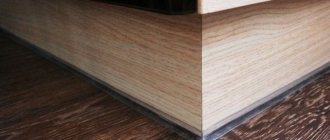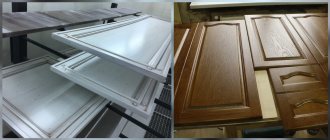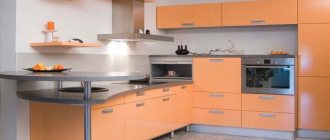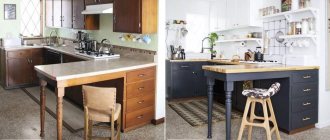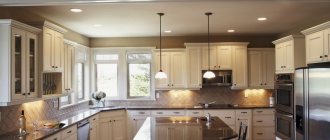Photo: fi.pinterest.com Many pieces of cabinet furniture are equipped with doors or drawers, and therefore handles for them. Sometimes these are almost invisible built-in latches or buttons, but more often they are very significant decorative elements. The convenience of daily use of storage systems, as well as the service life of a particular product, is directly affected by the quality of the fittings. The small classification collected in this article with characteristics and photographs of each type will help you choose stylish and reliable furniture handles.
How to position it correctly?
In order for the finished kitchen to look harmonious, you need to install the handles correctly. To do this, you will need to maintain a center-to-center distance and equal space on the top and sides. For convenience, use the template:
- Take a small piece of thin plywood and draw center lines along and across.
- Mark the correct position of the handle.
- Drill one or two holes (depending on type).
- Mark the center of each door or drawer.
- Mark future holes using a template.
To extend the life of handles and doors, install additional washers inside on glass and wooden facades.
Fastenings can be located not only in the center. Central placement is convenient for drawers. Standard cabinets, on the contrary, are more convenient to open from the side. In this case, the handles on the upper modules are installed from the bottom from the edge, and on the lower ones - from the top.
Vertical rails instead of horizontal ones or buttons will also make opening the cabinet easier.
Methods for attaching furniture handles
Ergonomics, reliability, and strength of handles on furniture facades largely depend on the method and quality of their fastening. Of course, the base material plays an important role - self-tapping screws will hold better on solid wood doors than on chipboard. For comfortable operation, heavy structures are equipped with larger width handles with at least two locking elements.
Fastening with one screw
Typically used for small knobs. The head of the screw is fixed on the inside of the door or drawer, and the spiral part is screwed into the base of the handle.
Fastening with two self-tapping screws
Typical for the installation of brackets, shells, and sometimes modernized rings and drops. In the brackets, the fastener heads are also hidden inside the facade and can be additionally protected with silicone/plastic overlays that protect against rust. If the design of the handle provides for an external base plate with slots on the sides, the screws are screwed in from the outside.
Fastening on steel hinges
Suitable for antique furniture, as well as rough drawers and cabinets in the loft style. In this case, the handle is supported on a base of forged door hinges. This option looks very unusual.
Drywall niche for TV: 75 photo ideas
Expert advice
When purchasing a finished facade, the location of the handles has already been determined. But furniture fittings have standard sizes, so you can always replace them if desired. You can update and install handles on cabinet doors yourself.
What you need to know when replacing fittings yourself:
- To drill holes for fasteners, use a drill of the required diameter. For railing models, a 5 mm drill is useful, but if the shape is such that it may not close the mounting hole, you need to take a 4 mm pointed drill.
- When attaching fittings to glass doors, you need to drill the glass with a diamond-coated drill.
- If handles need to be attached to new facades, then holes should be drilled using templates to mark the center of the holes. In this case, the symmetry of the arrangement of the handles will be maintained.
- When installing handles on wooden and glass facades, be sure to screw an additional washer on the back side for strong fastening.
Replacing handles on kitchen furniture correctly is not a difficult process. You can install traditional staples, or you can use products with Swarovski crystals - the installation depends on the interior of your kitchen and personal preferences.
Design and shape of handles for integrated and conventional kitchen fronts
Manufacturers of furniture fittings offer a huge range of products of this type. There are thousands of products on the market that differ in design, material of manufacture, shape and method of fastening. To understand all the variety and choose beautiful, durable and functional handles for your kitchen set, you should first familiarize yourself with the main varieties and features of this type of furniture.
Kitchen handles are made from the following materials:
- Alloys of various metals. An alloy of zinc and aluminum is often used, which allows the product to be given the most intricate shape while maintaining high strength. Bronze, copper, brass and other materials are used to make expensive products. The surface coating can be matte, shiny, gold or silver, or patinated. Plastic. Inexpensive material that does not have high strength and durability characteristics.
- Wooden handles for furniture. A natural, visually pleasing material that has all the necessary performance characteristics and harmonizes with wooden facades.
- Ceramic handles for furniture. They look original, but products made from quality materials are relatively expensive.
- Glass. Edges that refract light can give the kitchen an interesting look.
- A combination of different materials (metal with wood, ceramic or plastic inserts, wood with glass and other options).
Galvanic coating, used by serious manufacturers, significantly extends the service life of metal handles and protects the surface from scratches and abrasions. When purchasing, you should ask the seller if such processing is available.
Copper handles with patterns are well suited for walnut furniture.
Depending on the shape, furniture handles are divided into the following types:
- In the shape of a ring. They are made of metal, in harmony with wooden facades.
- Drop-shaped. A classic, inexpensive option, often used with plastic facades. From a practicality point of view, it is not the most convenient option, since the streamlined “drop” easily slips out of wet fingers.
- Sinks. The shape follows the downward-facing shell of the shell.
- Buttons. Compact products are made from all available materials, which allows you to choose the right option for any facade.
- Staples. The most practical and common option, providing a comfortable grip. Produced mainly from metal alloys.
- Railing handles for the kitchen are a smooth or matte tube of various sections, mounted on two supports. The distance between supports ranges from 96 to 800 mm. Ideal for interiors designed in modern or high-tech style.
Peculiarities
Before making an important purchase, you should decide and familiarize yourself with such characteristics as the main dimensions and composition. The most popular base for kitchen handles is a mixture of zinc and aluminum
Due to the high strength and good properties of these elements, products can last for many years without losing their original shape (which can be the most unusual and original) and shine
The most popular base for kitchen handles is a mixture of zinc and aluminum. Due to the high strength and good properties of these elements, products can last for many years without losing their original shape (which can be the most unusual and original) and shine.
Kitchen handles made of glossy chrome or bronze are considered no less relevant. The surface depends on the chosen style direction.
Bronze and imitation metal will make kitchen handles not just a convenient and practical device, but also an irresistible part of a sophisticated interior. This choice will appeal to connoisseurs of classic interior design. The quality and durability of such products has been tested over the years. The appearance is also able to maintain its beauty for a long time thanks to special sprays that are applied to the finished surface.
Another interesting choice could be porcelain or acrylic. A single-color product will emphasize the laconicism of the kitchen, and details with painting or imitation crystal will add a special zest to the kitchen space.
As for the size of kitchen handles, it can vary depending on the center-to-center distance. These parameters must be specified in the instructions. Most often, sizes vary from 16 to 1050 mm (with a standard pitch of 30–32 mm).
Maintain proportions
There is an immutable rule: for a narrow facade we choose short handles. It is not only convenient, but also aesthetically pleasing.
If the modules of your kitchen set are almost identical to each other, feel free to purchase the same handles. But if you have both large cabinets and small drawers, choose handles of the same design, but of different sizes. However, here it would be useful to remember a sense of proportion. Two sizes - larger and smaller - are quite enough. Too many different knobs on one headset will look ridiculous.
Having trouble choosing? We'll give you a hint. The standard dimensions of kitchen cabinets and drawers are 600 mm. The distance between the axes of door handles for such facades will be 436 mm. If the cabinet doors are 500 mm wide, the maximum handle width is 336 mm. With cabinet widths of 400, 350 mm, handles up to 192 mm will be required. And for miniature, narrow cabinets, it is worth choosing handles-buttons or “shells”.
The main criteria for choosing handles for kitchen facades - recommendations from the editors of Homius.ru
Ready-made kits are already equipped with all accessories, but if you are making furniture according to an individual sketch, you can choose a model from catalogs
In this case, you need to rely not only on their external design; our editorial experts recommend paying attention to the following factors:
- convenience and compliance with the overall design of the kitchen;
- The width of the handle should be enough to cover the entire palm, not just a few fingers. The optimal center-to-center distance is 96-128 mm. To make the right choice, you first need to measure the width of your palm;
- the fittings should be chosen with a streamlined shape; for safety, there should be no sharp, traumatic corners;
- When purchasing, you must check the completeness, and all products must have the same shade;
- Only two sizes of accessories can be installed in the kitchen;
- For a small room you should choose compact fittings; the best option is hidden handles for the kitchen. Large sizes will overload the interior;
- all decor must be made in the same color. For example, shiny chrome fittings cannot be combined with matte bronze;
- If cabinets are installed near a wall, the horizontal handle may prevent the door from opening completely. In this case, it can be installed vertically.
Knowing the basic nuances of the fittings, you can make them yourself
Focus on convenience
External attractiveness, harmonious design - these are the aspects that buyers first of all pay attention to. Indeed, the combination of handles for kitchen furniture with facades is the key to success. It is necessary to take into account the color scheme, style, and geometry of the facades. It is equally important to choose accessories:
- made from high quality materials;
- suitable in size;
- ergonomic;
- durable;
- with reliable coating.
The main criterion for choosing high-quality accessories should be ease of use.
Every day you have to close and open kitchen furniture doors and pull out drawers. And the handles should be as “pleasant” as possible for your hand. Even the most beautiful fittings will be a bad purchase if it is uncomfortable to use. On display, all the furniture handles look attractive. But in order to make the right choice, be sure to hold the product in your hands. Ideally, if the width of the handle is not a couple of fingers, but a whole palm.
If you order fittings along with a set in a furniture showroom, ask to see the handle you like in action on display samples. Try several options and find the ones that work best. Feel free to refuse trendy products if you feel discomfort when using them.
On the one hand, choosing on an online storefront is more difficult—you can’t pick up the product. But on the other hand, your choice will be more comfortable. The online store provides a detailed description of furniture handles and their sizes.
What should you pay attention to first? Find the center-to-center distance. It is optimal if it is 120-128 mm. The permissible minimum is 96 mm. And in order to “customize” these parameters for yourself, measure the width of your palm and focus on this value.
Types of furniture handles
Kitchen units, cabinets, chests of drawers, walls for hallways and living rooms almost always include many lockable compartments, access to which is provided by special holders - handles. Despite their small size, these functional accessories give furniture structures a complete look, and sometimes serve as an interesting addition to the design. Depending on the shape, handles can be divided into the following types:
Staples
These are ordinary strips or arcs that are fixed to two symmetrically located fasteners. The elongated shape and slight deviation from the surface of the facade makes it easy to open fairly large doors. There are straight staples, the surface of which is strictly rectangular, curved, semi-oval, with different decorative options. For example, vintage models are characterized by ceramic inserts - “barrels” or “medallions” with a floral pattern made in enamel. In the classic style you can often see carved, forged parts or even almost jewelry inlay.
Railings
A somewhat elongated and more modern subtype of staples. Often a metal pipe, strip or spindle-shaped arc is used - any narrow crossbar that occupies from 1/3 to 5/6 of the door width. This design distributes weight well, so it can be used for drawers with kitchen utensils, shoes or other heavy items.
Built-in (integrated) handles
They are an aluminum profile mounted into the surface of the facade. It can be hidden along the milled end - then the door looks absolutely smooth, and the presence of fittings is only revealed by a thin strip along the edge. The second fashionable option is mortise handles, which are often used in modern design trends such as minimalism or hi-tech.
Buttons
In appearance they are somewhat reminiscent of buttons - they have exactly the same “leg” and a very varied design on the outside. Round, oval, square, in the shape of flowers, leaves, pins and other interesting things, these handles can harmoniously complement any interior. However, their characteristic single fastening and small size are suitable mainly for compact furniture with small doors and light-weight drawers - for example, a linen chest of drawers in the bedroom, children's bedside tables, dressing table.
Ring pens
This is probably one of the oldest types of fastenings. They were already found in medieval chests - durable forged linings facilitated the process of transporting heavy boxes. On modern furniture, rings serve more of a decorative function, but this in no way reduces their convenience in everyday use. In addition to historically stylized rings made of iron, bronze or copper, there are also lightweight options - chrome-plated or gold-plated products made of steel, aluminum, zinc alloys.
Drop pens
A characteristic feature of Gothic interiors, and in a more refined form - Renaissance and Victorian classics. Here the moving part, i.e. the teardrop or brush shaped pendant, is attached to a base with a roller tip. Initially, this design was used to knock so that the inhabitants of a fortress or monastery would hear it and open the heavy door
When using teardrop-shaped handles at home, you should be careful so that constant impacts do not cause dents on wooden facades.
Sink handles
They are rare, but this is a very good choice for furniture in the Mediterranean style, shabby chic and Provence. Geometrically, they repeat an inverted hemisphere - a shape that is repeated many times in the rustic architecture of southern Italy and France (arches, ceilings, window openings, stoves). But buttons with a decor in the form of a seashell, although they look quite nice, do not belong to this category.
Materials for furniture handles
Since the handles of cabinets, chests of drawers and drawers are regularly exposed to mechanical stress and are intended for many years of use, they are made only from durable materials that are not subject to destructive conditions.
Wood is used extremely rarely for this purpose - only small buttons are made from it, but they also quickly become unusable. Antique and expensive modern furniture is equipped with high-quality fittings made of metal or ceramics, which do not lose their original properties even after hundreds of years.
Tree
Wooden handles can be seen in walls and small bedside tables, which are placed in dry rooms - living room, bedroom, hallway. Their advantage is their low price and visual harmony with the furniture material, but from the point of view of durability this is far from the best option. Wood, even very well processed, soon dries out, does not adhere well to the fastening, wobbles and falls off, requiring replacement or repair.
Plastic
Affordable, moisture- and dust-resistant plastic often replaces more expensive products. However, its strength in most cases leaves much to be desired. Because of this, handles using plastic are most often installed in children's furniture, which is purchased for 3-5 years and for which, first of all, a bright toy design is important.
Ceramics
Ceramic handles are an attribute of vintage furniture in the style of shabby chic, Provence, and rustic. They harmoniously combine with wooden furniture in the kitchen, echoing the same colorful dishes, and look very elegant in the bedroom, bathroom, and living room. The exquisite beauty of the painting and the antique shape of such handles gives a special charm not only to the cabinets, but also to the interior as a whole.
Metal
Forged, cast, stamped accessories made of stainless alloys of copper, iron, zinc, silver are perfectly preserved for centuries, as confirmed by numerous museum exhibits and antique pieces of furniture in private homes. Modern fittings, for which chrome-plated steel or aluminum are usually used, are not inferior to them.
Decorating the walls in the toilet: materials and ideas (65 photos)
Style Compatibility
Most people do not adhere to a specific style when choosing a kitchen set. Their preferences are limited to two main categories: classic or modern. When purchasing a ready-made headset, the question of choosing handles is usually not an issue.
But if you decide to create the kitchen of your dreams yourself, to make it to order, you need to think through everything down to the smallest detail: the layout of the kitchen modules, the material and color of the facades and, of course, furniture handles. To do this, you need to have at least minimal knowledge in the field of design and understand the basic styles of kitchen interiors.
Watch this video on YouTube
Classic
This style is characterized by restraint and elegance. Precious wood, stone and ceramics are used in interior decoration. Colors are muted, matte, dim. Brown, beige, white, gray, pistachio, etc. are appropriate. Kitchen facades can be decorated with carvings, milling or panels.
The shape of the handles for the classics is sophisticated staples or rounded buttons. Material – metal, wood, ceramics. Colors – antique bronze, blackened silver, copper, brass, tin. Small inserts made of porcelain or enamel in a retro style look harmonious. Handles should not be massive; the main task is to emphasize the beauty of the facades.
Handles for a white kitchen are more difficult to choose. Focus on the color of the countertop. For example, antique bronze is suitable for a brown tabletop, matte nickel is suitable for a gray one, and blackened silver is suitable for a black one.
Provence and country
These styles are very similar to the traditional classics, but each has its own nuances.
Provence, or French style, is distinguished by light painted wooden facades and an abundance of decor from textiles, glass and ceramics. The color of the furniture is lilac, beige, white, blue, light purple or green.
Country - rustic style. Aged furniture made of natural wood, pottery, linen curtains and tablecloths create a unique atmosphere of old-time flavor and comfort. Kitchen fronts are more massive, which is why this style is not suitable for small kitchens.
Select furniture fittings for Provence and country styles according to the same principle as for traditional classics. Sinks made of patinated copper or brass are also suitable here. The main principle is natural materials, warmth and comfort.
Modern
In a modern style kitchen, everything is functional and practical. There are no unnecessary elements or decorations. Lots of modern household appliances, the kitchen space is ergonomic. Facades can be of a variety of colors and shades, and the surface can be glossy or matte.
The shape of the handles is brackets in a modern style, railings, profiles, mortise options. Color – steel, aluminum, chrome, nickel. The buttons are miniature, matching the color of the main handles and only on narrow hinged doors or glass inserts.
High tech
Dynamic modern style. Strict line geometry, glass inserts in metal frames, built-in stainless steel household appliances in vertical special modules. The facades are two-colored and bright. One color is dominant, the second is contrasting.
The shape of the handles is brackets or rectangular rails, profiles, mortise options. Color – steel, aluminum, chrome, nickel.
Minimalism
The name of this style speaks for itself. Strictness and conciseness can be seen in everything. Smooth glossy facades, no decoration or frills. Hidden fittings are selected especially carefully: the most modern sliding and lifting mechanisms are used.
Kitchens of this style usually do not have handles. Opening the doors and pulling out the drawers is done by lightly pressing the hand on the facade panel. Sometimes integrated handle profiles are used across the entire width of the modules.
Loft
This is an industrial style. It uses rough finishing materials: brick, untreated stone, plaster, concrete, metal. They are combined with bright furniture, decorative elements or lamps.
Fittings in the loft style are selected in accordance with the facades of the kitchen unit. If they are made in a modern style, brackets, rails or a profile will do. For rough wooden facades - buttons or rough-shaped staples.
Color - aged copper, brass, nickel, pewter or iron with patina. Some manufacturers produce special original handles for the loft style in the form of door hinges with rivets, keys or nails.
Features and Benefits
A kitchen set is bought for more than one year, so it is very important to understand that high-quality mechanisms and fittings make the use of the furniture long and comfortable. Kitchen cabinet handles, being an important element of furniture fittings, are created not only for convenience. As stylish front decorations, they give kitchen fronts a complete look and form the overall impression of the kitchen.
Kinds
The variety of shapes and wide price range of furniture handles offered by hardware manufacturers makes it possible to match them to kitchen furniture of any style.
One of the most commonly used varieties are overhead handles. Freely grasped by hand, staples are distinguished by U-shaped or arcuate geometry. The brackets are securely attached to the door with two screws; the distance between the axes of screwing in the fasteners on some models reaches 480 mm. Typically, staples are used on wide fronts and large ends of deep retractable storage systems equipped with closers.
The doors of kitchen modules in a modern style are often equipped with railing models of handles of simple geometric shapes. Railing models are sections of a straight thin cylindrical rail with two holder legs. Frequently installed handle models have a distance between the fastening axes from 96 to 608 mm.
The design of the handle-button resembles a mushroom, attached to the front surface of the cabinet with a single screw. Such door buttons belong to furniture classics, are rarely used in modernist models of sets, but are actively used in such stylistic directions as Provence, country and retro.
The shapes of handle-buttons are round, elliptical, square and triangular with a flat or convex surface. There are fantasy models in the shape of a ball, flower, star and animal figure. Buttons are used on narrow kitchen doors or the front end walls of shallow drawers.
Elegant cut-in models satisfy the needs of discerning buyers who are not satisfied with protruding parts on the doors of kitchen cabinets. The handles are built into the door or drawer front and blend completely into the shiny surface of the front without being noticeable. Ideal for furniture in a minimalist style. The disadvantage of such models is the rather complicated installation, which involves cutting out a recess of the desired shape in the facade, so they are rarely used in kitchen furniture.
Connoisseurs of minimalist kitchen design solutions who do not want to see unnecessary protruding fittings should pay attention to hidden designs in which the handle maintains the illusion of a completely smooth facade. Visually invisible fittings are a vertical or horizontal groove located at the edge of a door or drawer, creating a small recess.
Profile models are long pieces of linear plastic or aluminum profiles that ensure unity with the facade, fitting tightly to the bottom or side of the door, almost without protruding beyond the edge.
Quite rarely there are other decorative types of products with a single method of fastening in the form of rings, drops and shells. These handles are awkward to grip, more appropriate on the doors of antique cupboards, and don’t look good in today’s kitchens.
Materials
All kitchen mechanisms, including facial decorative elements, are used repeatedly every day in conditions of changes in humidity and temperature fluctuations, which negatively affect the appearance. The long-term and trouble-free operation of handles and the preservation of their aesthetic appearance depend on the correct choice of material. Modern handles are made of metal alloys, copper, aluminum and wood. There are also ceramic, glass and plastic models.
Eco-friendly wooden products look good in ethnic-style kitchen sets. In an effort to emphasize the interesting texture of natural wood, you can combine handles with a completely smooth surface. It must be remembered that wood is not particularly durable; the handles may become damaged during frequent use.
The range of facade accessories from foreign and Russian manufacturers made from such practical materials as aluminum profiles, metal zinc and aluminum alloys, is valued by professionals and ordinary consumers for their durability and resistance to corrosion, mold and mildew.
Elegant models made of copper, brass and bronze are perfect for kitchen facades with various stylistic solutions, but they require careful maintenance to maintain their appearance. Beautiful handles with glass elements, ceramics and porcelain are not difficult to care for, but such products require a certain margin of safety; low-quality products can be very fragile.
The possibility of long-term use is distinguished by handles with galvanic chrome plating. Decorative galvanic coating is a thin layer of metal that protects against oxidation and increases the service life of the product. The application of a chrome coating after the thread serves as protection against subsequent corrosion at the fastening points.
The surface of inexpensive fittings is often treated with metal spraying, as a result of which it looks better than expensive analogues. Spray particles remaining on the fingers during inspection indicate the low quality indicators of this fitting, which, if exposed to negative kitchen factors, will quickly become unusable.
Popular types of kitchen handles
When you come to the store without preparation, you will see a huge amount of different accessories. With such a variety, you can get confused and buy something that doesn’t suit your interior. We have collected the most popular types, from which you can easily choose what you need.
Handles
The most popular kitchen handles are pull handles. They usually have an arcuate or U-shape and are securely fastened with two screws. Such handles are considered comfortable and wear-resistant; they are recommended for installation on cabinets that will have to be opened frequently.
Handle brackets can be mounted both horizontally and vertically. This is their advantage. For example, identical handles can be attached horizontally to drawers and vertically to cabinet doors. This will add zest to the interior.
Photo: trademaster.com.au
Knobs-buttons
The fittings in the form of buttons are very laconic and compact. It is easy to screw on as it is held on by one bolt. Handles come in different shapes. Round and oval ones are used more often, but square and more original shapes of handle-buttons are also found.
This type of fittings is not suitable for heavy drawers. But it also has advantages. For example, it is much easier to protect your kitchen set from dirt if you use the round handle rather than the bracket handle.
Photo: pronteau.co.uk
Built-in handles
Built-in or mortise handles are suitable for cases when there are too many decorative elements in the kitchen interior
The built-in handles are invisible, so they will not distract attention from the main decorations. They are convenient for those who have small children, since the fittings are recessed into the furniture and attract children’s attention less
However, this type of handle is difficult to install and only on straight surfaces.
1/2 2/2
Progress has reached the point that they now even produce touch-sensitive handles with LED backlighting, emphasizing the elegance of the furniture. A light touch turns on the lights hidden inside the handle, which go out on their own after a minute. The handles are powered by regular batteries contained in a neat power supply that is hidden behind the front of the shelf.
Photo: oops-cache.org
Profile handles
A handle profile (or molding handle) is an aluminum or plastic profile that is attached to the kitchen door from above or below. It can be fixed so that it does not protrude above the surface and merges with the facade. The handles on the drawers are very noticeable, but this is not a drawback, but simply a feature of the fittings.
Photo:
Handles of unusual shape
Handles in the shape of tablespoons or climbing men are very fun, but if you want to use them, you need to be as sure as possible that they fit with the overall concept of the interior. They will look good as accents in a kitchen made in a minimalist design and soothing colors.
1/3 2/3 3/3
Selection of handles taking into account the style of the kitchen
The fittings you choose for your kitchen furniture should match its style. For example, if you are decorating in bronze tones, glossy white handles will look strange. Let's figure out in what style which pens will look appropriate.
Classic style
A traditional style kitchen is characterized by elaborate details and carvings on the wooden cabinet doors. Often, designers choose bronze-colored handles or handles with porcelain inserts to highlight the elegance of the room.
instagram.com
1/3
thepeakofchic.blogspot.com
2/3
thesweetestdigs.com
3/3
Neoclassical style
Neoclassicism is distinguished by the fact that it mixes classical and modern elements. Simple handles without carvings or decorations, such as universal handles, will look good in this style. In this case, it is better to select the colors to match the style of the kitchen, since the fittings are available in various shades: chrome, bronze, gold and wood.
deringhall.com
1/3
housebeautiful.com
2/3
ottawacitizen.com
3/3
High tech
High-tech kitchens are characterized by straight lines, lack of decoration and minimalist colors. Therefore, in this style it is better to use simple and convenient fittings, such as aluminum rails. They will look good in combination with steel-colored elements, which are often used in the interior of modern kitchens.
Photo: mukuro.net
General recommendations
From all of the above, it is clear that the lack of familiar fittings gives rise to one significant problem: the facades of the furniture quickly become dirty. To solve this problem, experts advise choosing light-colored sets and purchasing kitchen cabinets without handles in white, blue-gray or light gray with a semi-gloss texture. Satin facades with a matte, slightly rough surface are easier to clean.
The most impractical variation is gloss black. You will have to constantly take care of this model. Any fingerprint will spoil the appearance of the product. You can buy such furniture if you can pay for the services of a visiting housekeeper or an apartment cleaning assistant.
Not everyone is mentally ready to completely give up their usual pens. In such a situation, experts advise using a compromise: making the upper cabinets without fittings and equipping only the lower tier with handles. Photos of such headsets show how successful the proposed solution can be.
The top has no handles, the lower cabinets have an integrated profile instead of handles Source twgram.me
Modern kitchen furniture manufacturers like to combine and use several opening and closing systems at once. For example, they equip the upper cabinets with a “Push-open” mechanism, and the lower ones with “Gola” profiles.
Self-installation: does size matter for horizontal and vertical installation?
To install kitchen handles on your own, you will need a set of tools that every skilled owner has: a drill with a drill of the required diameter, a screwdriver, a tape measure and a pencil. Installation is performed as follows:
- The placement height is determined and markings are made. The choice of height should be approached from the point of view of convenience for all family members and taking into account the height of each person living. Opening the door of a hanging cabinet should not require the use of a stand, and the door of a cabinet should not require squatting or bending too low. If the door has a panel installed, markings for the holes are made on the side frame.
- Having determined the optimal height, a template is made from cardboard so as not to make the same measurements for each individual door. It is worth paying attention to the symmetrical arrangement of products on drawers.
- Installation is carried out on unattached doors placed on a flat surface. Two wooden blocks of equal height are placed under the façade.
- Holes are drilled according to the markings.
- An overhead washer is installed on the reverse side and a mounting bolt is screwed in.
Setting dimensions and drilling the façade
Let's start by installing handles on the doors of the kitchen unit.
- The door is placed on a flat surface, let it be a table.
- In the corner where it is necessary to install the handle itself, a distance of 5 cm is set aside from one and the second edges.
- Two mutually perpendicular lines are drawn through the points. Their intersection point is the place of the first fastener. In order for the lines to turn out to be mutually perpendicular, it is necessary to use a square to draw them, applying it to the edges of the door.
- Now you need to accurately measure the distance between the mounting holes on the handle itself.
- This value is transferred to the door from the point of intersection of the two lines. If the fitting element will be installed vertically, then the displacement must be carried out downwards, if horizontally, then to the side. The second location for fastening the fittings is indicated. In this way, the exact location of the handles on the facades is determined.
- Now we need to drill. This operation is performed from the front side of the facade. The thing is that when the drill comes out of the material, it may delaminate and chips may appear along the edges. And although they will be closed with the fittings themselves, there is always the possibility of a large chip or crack appearing. Of course, this all depends on the quality of the material used and the sharpness of the drill used. Therefore, when drilling, be careful and carry out this operation carefully.
- So, two mounting holes are drilled, now you need to insert two mounting screws from the back side. Install the handle on the front side and attach it to the facade, screwing in the screws with a screwdriver. If it is not pressed tightly against the door and is loose, then you will have to remove it, put washers under the heads of the screws, and put the fastening back on.
Before screwing on the handles, it is necessary to clean all surfaces from dust and particles of the material from which the facades were made. So, the handles are installed, you can hang the facades on the hinges.
Form determines content
The ergonomics of fittings depends not only on the size, but also on the geometry of furniture handles. Modern manufacturers offer a wide range of not only design solutions, but also shapes. Among them:
- handles and buttons;
- shells and “earrings”;
- roof rails and profiles;
- mortise and overhead fittings.
Which of the listed forms will be the most convenient depends on your preferences. Don’t forget about the harmonious combination of the façade design and the fittings installed on it.
Handles
This option is among the top leaders in terms of popularity. Such front fittings are easy to use, look stylish and fit with most kitchen sets: from timeless classics to modern or current loft style. The shape of the handle-bracket is similar to the letter P. There is another option - brackets in the shape of a curved arc. The first option is ideal for modern kitchens, the second is perfect for a set in a classic style, for furniture in the styles of Provence, shabby chic, country and many others.
An important advantage of handles of this shape is the ease of their fastening. The products are fixed to the facade at two points - it is safe and reliable.
Knobs-buttons
In the assortment of such furniture fittings, both fans of minimalism and lovers of creative solutions will find a suitable solution. A button is a simple shaped handle. The design of such products can be varied. The round head makes the handle look like a mushroom on a stalk, and the decorative flat disk sets a more strict and laconic style.
Furniture handle-knob shapes are presented in a large assortment:
- square or rectangular;
- in the shape of an oval or circle;
- in the form of a flower, with plant or any other fantasy forms.
Attaching the handle-button to the facade is as simple and convenient as its design. The handle is secured with a single bolt. However, this does not interfere with the excellent functionality of the product, its reliability and convenience.
Shells
This option of front fittings is relevant for kitchen sets in an eco-friendly style. Externally, the shell handle looks like a rare metal bowl or a sea shell. The curved, voluminous shape of the product creates a spectacular natural style and ensures ease of everyday use. Such handles are suitable for interiors in any color range - from snow-white to black facades, from delicate, pastel to bright and bold design solutions.
Handles-“earrings”
The non-standard design of furniture fittings is ideal for a set made in a classic style. Furniture in the color of natural wood, snow-white, beige and many other facades will look even more impressive if you install handles with a drop-shaped or round moving part on them. Such products, as a rule, can be found on expensive premium kitchen sets made from natural materials (including rare and exotic woods).
Railings
The shape of furniture handle rails is stylish and laconic. This is a crossbar, shaped somewhat like a handle-brace. This product is fixed on two legs. The difference from the “bracket” is that between the mounting legs there is not a curved crossbar, but a straight one. The design also differs in that, as a rule, the crossbar in the roof rails is extended beyond the legs. This design solution looks quite stylish and unusual, which is why roof rails are so often used for modern headsets.
Most handles of this shape are discreet in design, even minimalistic. But at the same time, this is an almost universal solution. The handle will suit both classic and trendy furniture.
The convenience and practicality of the railing also lies in the ease of its installation. This handle can be fixed on kitchen cabinet doors in both horizontal and vertical positions. It all depends on your preferences and the design of the facades of the set.
Profiles
Profile handles are at the peak of popularity today. They can be made of a metal profile - aluminum or steel. The bar of the product is made in two current forms - in the form of the letters P or G. The grip on the profile handle can be either straight or rounded. The strip is fixed at the end of the kitchen facade, which is also very convenient.
Mortise handles
The main feature of the model is that it completely merges with the surface, creating a harmonious design. As a rule, such handles are installed directly when ordering a kitchen set. This is due to the nuances of their installation. In order to install the handle, the facade is pre-milled, creating the necessary recesses. They can be located both on the front of the door and at the end.
If you want to install mortise handles after purchasing the headset, entrust this work to an experienced craftsman: you cannot do this without professional equipment.
Overhead models
Such handles are installed on the front part of kitchen facades. The fittings have a bottom grip, which is convenient for many housewives. In this regard, overhead models are similar to profile products or “shells”. The handle fits tightly to the facade, decorating the set and creating a feeling of good quality, quality, and reliability.
Material
To make the most durable and strong kitchen handles, metals of various alloys are used. You can find out what type of metal is used by looking at the product label:
- Zamak is an alloy of magnesium, copper, zinc and aluminum;
- Znal is an alloy of aluminum and zinc.
To reduce the price of rather expensive metal fittings, manufacturers apply a coating that imitates metal. Thus, affordable and high-quality products are obtained from copper, bronze, silver, gold, chrome, brass, nickel
However, it is important to know the coating application method:
- galvanic – a metal ultra-thin film that is applied using electroplating. Gives handles an aesthetic appearance, increases wear resistance and reliably protects against corrosion;
- spraying is a cheap paint coating that looks beautiful in appearance, but will not last long, especially under conditions of temperature changes and high humidity.
- handles made of lightweight plastic, wood, glass, acrylic, leather are no less impressive and will last you a very long time. But keep in mind that it is better to place facades with non-metallic handles away from the oven and grill. Leather, wood and plastic products do not tolerate heat well.
Caring for fittings on a furniture set
What products to choose for caring for kitchen fittings depends on the material of the parts:
- Galvanized metal can be wiped clean using any means. Abrasive compounds are used sparingly.
- Chrome and nickel - use a damp microfiber cloth. It will cope with fingerprints and grease deposits.
- Wood - wipe with a slightly dampened cloth and immediately wipe dry. A small amount of polish is allowed for shine.
- Plastic - soap solution. Aggressive cleaning mixtures can damage the material.
- Glass can be washed with special means for this purpose.
- Ceramics - the product can be wiped with a soft brush or sponge without the use of aggressive compounds (no alkali).
- Coating bronze, silver, gold - a soft brush and soap solution.
Choosing handles for the kitchen - tips
Hidden handles are popular these days. Almost all headsets are produced with this type of fittings on the facade. Designers advise introducing modern furniture into apartments, but we do not completely agree with this statement. Look at the comparison table of the pros and cons of hidden handles and draw your own conclusions.
| pros | Minuses |
| Keeps clean longer. When preparing food, your hands are not completely clean, and you need to open drawers. This can be done with little loss if you install built-in handles on the lower cabinets that swing open when pressed with your knee. | For many, such pens are expensive. Because you need to install high-quality types, Chinese ones won’t do, they will break in a month. |
| If there are kids in the house, then hands are the main place to go to the kitchen. Therefore, their absence will save children from injury, dishes from breaking, and also your nerves. Even if children are adults, they can hit and get abrasions while playing. | If integrated kitchen handles open the doors when pressed (for example, by the knee), then accidental openings cannot be avoided. This will cause discomfort and injury. |
| Space is saved. Often in small kitchens handles are not installed so as not to interfere with opening. Especially for corner sets. | Now it’s not the usual handles that need to be cleaned of dirt, but the façade. For gloss this is a problem; the lightest touches will be visible. If you install matte panels, fingerprints will become less noticeable. Also, dirt and fat deposits will accumulate in the recesses. They are easier to clean, but still need to be done in addition to the façade. |
| The room becomes more modern. The current trend is handleless, so you won't fall behind in the design world. | |
| There will be no unnecessary interference. For example, when carrying boiling water, you won’t be able to accidentally get caught and get wet. And those who are used to listening to songs through wired headphones will have nothing to cling to. |
The selected fittings should complement the kitchen set - you should not blindly chase fashion.
Review of types of kitchen handles
Bracket
The most common type of handles, convenient due to their curved shape . A universal option that is suitable for any style kitchen.
Railing handle
A type of handle-brace, but with a straight, strict shape. The railing (crossbar) can be placed beyond the boundaries of the handle or not beyond them. Suitable for high-tech or minimalist style , less commonly used in lofts.
Ring
The handle is quite non-ergonomic and is suitable for classic kitchen sets.
Button
May have different sizes and shapes. Due to its compactness, it facilitates the appearance of the facade. It is attached with one screw, so it is not reliable, and if you fix it on a bulky facade, there is a chance that it will fall off. It is advisable to combine it with a companion handle, for example, with a staple. The kitchen set takes on an original look, but functionality does not suffer.
End (built-in) handle
Attached to the top or back of the facade. Suitable for creating a minimalist effect. When using such a handle, our customers note that they constantly have to touch the surface of the door, which causes it to get dirty and even scratched. Some people complain that such a handle is uncomfortable to grip.
Mortise handle
This handle requires labor-intensive and complex installation. To install it, you need to cut out part of the facade, which is highly not recommended. Especially if you turned to unreliable installers. It will be impossible to fix the expensive façade later.
GOLA
The hidden, integrated Gola handle was a trend last year and is still popular today. A modern, stylish option, the installation of which requires minor manipulations with the body. Great for high-tech style. However, many men complain that their hand is too large to comfortably open a door with such a handle.
A drop
An excellent option for classic style, shabby chic or Provence. Not very convenient for daily use, like the option with a ring. But aesthetes will tolerate any inconvenience.
Shell
A good solution for Provence, Mediterranean style, shabby chic and classic. Since the user always grips the inside of the handle, the outside of the handle always remains clean. Helps soften the “squareness” of the facade. However, it is not always convenient to take it on.
Rhinestones
The form can be any. The main highlight is rhinestones, which can be of any size and in different quantities. Will add chic to any kitchen. The main thing is to take proper care of it, because worn out, dirty rhinestones will look very sad.
Touch pen with LED backlight
For lovers of high technology. Lights up with a light touch of the hand. The LED strip can burn out either as a whole or as individual bulbs. In addition, you will need to change the batteries periodically.
Tips for choosing kitchen handles
When choosing a handle, check how comfortable it is to grip it with your whole palm, rather than with just two fingers. This will make opening drawers faster and easier. The material should be pleasant to touch , because you come into contact with it every day. The handle should not have sharp edges or corners as they make it unsafe.
Manufacturing materials
When choosing, you should consider the material from which the hand is made.
| Type of material | Advantages | Flaws |
| Metal (steel) | It is not afraid of moisture, low and high temperatures, and is not susceptible to fungus and rust. Suitable for almost any kitchen with the right choice of accessories. | Glossy surfaces leave fingerprints. Matte surfaces are difficult to clean, only with the help of a special product. |
| Copper | They clean well and look expensive. | They suit a very small number of kitchen style options. |
| Glass | Custom look, easy to clean. | Careful and careful use is necessary, as glass is a fragile material. |
| Ceramics | High strength, noble appearance of the product. Retains its original appearance for a long time and is easy to clean. It can be combined with many materials, but it looks especially beautiful with the color bronze. | Not resistant to mechanical damage. |
| Plastic | Not high cost, at the same time, it is possible to change handles frequently, light weight, easy to clean, and the ability to make an original shape. | Not durable, can be deformed when exposed to high temperatures. |
| Tree | Ecological natural material. | Does not tolerate high temperatures, does not have a very long service life, wears out quickly and loses its original appearance. |
The most common material for manufacturing is steel. It can have a matte or glossy texture. Italian manufacturers are highly valued in the construction market. A country like Italy has always had a favorable price-quality ratio. They also provide a good warranty on their products.
Interesting solutions in interior design
Against the backdrop of modern glossy facades, technologically advanced touch handles with LED backlighting look impressive. The stylish fittings are made of special plastic that diffuses light and lights up with a light touch. Different LED lighting systems are capable of distributing light outside and inside the cabinet and are powered by a block of ordinary batteries mounted on the inner surface of the kitchen door.
The simplest interior with an inexpensive kitchen set will be decorated with original designer furniture handles in the form of spoons, forks and knives.
Review of the best manufacturers
European branded fittings from Italy (Eureka, Premiere Furniture, Colombo Design, Bosetti Marella, Besana), Spain (Estamp), Germany (Union Knopf) and Belgium (Metakor) are traditionally distinguished by their quality of workmanship, precise ergonomics and unique shapes. Mother of pearl, precious and semi-precious stones, and genuine leather, used by Italian craftsmen to decorate handles, turn kitchen sets into works of art.
Today, Boyard from Russia provides furniture handles that are optimal in price and quality. A wide range of products with good quality are offered by Polish manufacturers Gamet, Nomet, REJS. On the shelves of large centers selling furniture, IKEA, OBI and Leroy Merlin, today there is a variety of fittings for kitchen furniture from Russian and foreign companies in a wide price range.
Preferred Materials
It is no secret that drawers are opened with handles up to several dozen times a day, which requires increased strength from the material from which they are made. Most often, an alloy of metals is used for these purposes - aluminum and zinc. Depending on what color the manufacturer wants to achieve, copper and magnesium may be added to the alloy. Thanks to such alloys, the result is durable handles with a slight chrome sheen - a universal option for any kitchen.
If the fittings must correspond to a certain style, you can choose options with a decorative coating that imitates a certain metal - silver, bronze, nickel and others. This is convenient when the color of the handles must match the tone of the countertops or other interior elements.
Imitation of antique metal is also a very popular option, which manufacturers achieve by applying a special composition to the metal. This method is called patination.
Metal is not the only material that can be used in a kitchen set. You can also find furniture with wood, plastic and porcelain options. The first option is found in vintage furniture; it is environmentally friendly, but requires more time for care and cleaning. Porcelain handles are an element of a sophisticated and airy kitchen; it is extremely impractical, but looks very impressive. Plastic handles are the shortest, but also the cheapest, so their use is advisable in order to save money.
How to choose the right one
Typically, handles are included with purchased furniture, but there may be a need to purchase separate custom-made fittings. Manufacturers make models for every taste and color. The main thing is not to make a mistake with the choice and buy the option that best suits the style of the kitchen and at the same time will have a fairly long service life.
The following recommendations will help you choose a high-quality and optimal option:
- Before purchasing in a store or after receiving a model ordered from a catalog, the handle should be carefully inspected for chips, cracks, and all decorative elements should be well secured.
- The width or length of the fittings must correspond to the parameters of the facade on which it will be attached.
- If the kitchen is small, then you should not select large and massive models, as they will visually overload the space.
- The fittings must match the chosen style of the kitchen: for classic or country style, artificially aged or antique models are suitable, and for a modern style - overhead brackets, rails, mortise or profile options.
Kitchen cabinets should not be placed close to the wall or against each other, because when opened, the handles will rest against the wall, and this can damage the wallpaper or other finishes.
Color solutions and decor
Collections of furniture accessories, presented in a variety of colors and finishes, allow each consumer to choose any model of handle for their kitchen set in accordance with their own preferences.
Modern kitchens are dominated by decorative elements coated in matte or glossy chrome. The geometric shapes of chrome-plated decorative elements perfectly meet the requirements of functionality and ergonomics of furniture modules of stylish modern and high-tech kitchens.
The assortment of furniture stores includes a variety of models with decorative coatings that replicate the texture and metallic shine of gold, silver, bronze, brass and tin. On the doors of classic, antique-looking kitchen units, and in rustic-style kitchen models, handles with ceramic inserts with painted floral arrangements and imitation antique bronze metal look great. An antique look is given to the metal coating by using patination technology using special solutions.
Complex unique models inlaid with rock crystal or with Swarovski crystals will undoubtedly decorate the interior of the kitchen space and attract attention with their chic appearance. Elegant furniture buttons and brackets with rhinestones are ideal for the doors of classic cabinets, adding shine and luxury to the strict dark and light facades of the Art Nouveau style.
Today, manufacturers offer up-to-date accessories with inclusions made from materials in a rich color palette: transparent and translucent plastic, acrylic, wood, glass and leather. Tastefully selected handles will be the finishing touch of color in a unique furniture design. Matching handles will become a harmonious addition to the kitchen. Bright, contrasting color models, on the contrary, will make the necessary emphasis on themselves.
The strict form of furniture handles, brackets, rails or black drops is ideally combined with kitchen facades built into loft-style rooms, using simplicity in combination with elements of modern decor: shiny steel, a lot of glass, cold gray wood, black or white plastic.
How to choose?
When choosing suitable fittings for the facades of kitchen modules, you should pay attention to the following points:
- handles should not only match the design of a particular set and decorate the doors, it is desirable that their dimensions correspond to the dimensions of the facades, vertical or horizontal placement contributes to the convenient repeated opening and closing of doors and drawers;
- In order for handles to comply with safety standards, their surface must be smooth without defects in the decorative layer, there should be no sharp edges or roughness;
- when determining the convenience of gripping the bracket, you should use the width of the entire palm, and not a pair of fingers, focusing on the required minimum center distance of 96 mm;
- when purchasing, you need to pay attention to the coincidence of the shade of the metal with the color of the other elements of the set and the interior of the kitchen; the combination of matte and shiny products, handles with gold and chrome coating in one set will not be harmonious;
- the quality of the handles implies the same shade of the coating of the entire set, the absence of scratches and chips on ceramic and porcelain parts, reliable fastening of medallions and rhinestones;
- handles that are too large visually overload the upper facades and the room as a whole, so for small kitchens it would be preferable to use compact facade fittings with a laconic design.
In kitchen modules with a front width of 600 mm, furniture makers recommend using long handle rails with horizontal fastening and a center-to-center length of 436 mm. The average door size of 350-450 mm dictates the installation of furniture handles with a distance between the fastening axes of up to 192 mm. On narrow cabinets 200-300 mm, small samples with a distance of 96 mm or fittings in the form of buttons or drops are attached.
How to hang it correctly?
For the purpose of convenient transportation and to avoid damage to the fittings, kitchen fronts, as a rule, are delivered without handles. Knowing some subtleties, it’s not difficult to attach the handles yourself.
Depending on the type, door handles are usually secured with 1-2 universal screws. The use of additional washers as a spacer between the screw heads and the door will protect the facade made of glass, solid natural wood or high-quality plastic from pressure from fasteners, damage to the door and handle, and will extend the life of the kitchen set.
When installing a kitchen, you need to pay attention to the optimal distance between the cabinets adjacent to the corner and the wall. When placed close to each other, the cabinet door will not be able to open completely. Or, if the opening angle is too large, the door handle will damage the wall finish. You can change the opening angle by installing a vertical handle instead of a horizontal one. You can increase the distance from the wall to the cabinet by a few centimeters.
How to choose kitchen furniture handles
Today you can see furniture with built-in handles, but most often people want to independently (or with the help of a specialist) choose exactly the model that is ideal for the overall interior style, color scheme and individual features of the kitchen space. We have collected simple tips to help you in the difficult task of choosing:
1
Pay attention to comfort. You need to remember that the main function of this product is opening and closing drawers, which should be as convenient as possible
Before purchasing, feel the handle in detail from all sides and check whether it is comfortable for your hands.
2. Safety of fittings. Carefully check the product for any defects (scratches, nicks) that could not only spoil the aesthetic appearance of the pen, but also harm your health.
3. If you decide to place the handle in a horizontal position, remember that the choice should fall on a small product. If you select a bulky part, opening the door will be inconvenient.
4. If the kitchen furniture is made in the same (or approximately the same size), then you can safely use one type of handle for all drawers. If the elements are very different from each other, select each handle individually.
5
If you are the owner of a miniature kitchen, then pay attention to profile handles or products with a built-in “push and open” mechanism. This will be a great addition to a small space
6. Handles made of gold, silver and copper are ideal for classic interior design, products made of porcelain and chrome will fit well into country and Provence style, elements with wooden inserts can complement the loft style.
Style is the focus
Having decided on the optimal shape, set a course for choosing a suitable design. The main condition is that the handle must match the facades in style, color, and size. It is important to correlate the design of the fittings not only with the furniture, but also with the overall interior design of the kitchen space.
There are several rules that will help you make the right decision. So, for a classic, high-quality set, owners most often choose handles and earrings. Bronze, gold-plated or silver-plated, with an aging effect, they perfectly complement the beauty and luxury of natural wood in any shade.
Style in the kitchen
Handles, shells or buttons in a rich range of colors look harmonious on classic furniture: gold, silver, bronze, brass. But chrome-plated, matte products are inappropriate here.
For a modern headset, an interesting option is laconic staples, overhead or mortise handles. Today minimalism is in fashion, so simplicity of form and ease of use are the basis here.
On furniture sets with impressively sized facades you can often see handle rails. This interesting solution is suitable for modern furniture with tall cabinets and wide drawers. And in order to make the kitchen space even more harmonious, the same roof rails are installed on the kitchen “apron”.
For fans of minimalism, one of the best solutions is profile handles. On a glossy monochromatic façade, this fittings look organic: they emphasize strict lines, precise proportions and stylish laconicism of the set.
Another trendy trend in kitchen furniture design today is Scandi style. The “Nordic” character of the headset is emphasized by practical models of handles: buttons, brackets, profiles.


